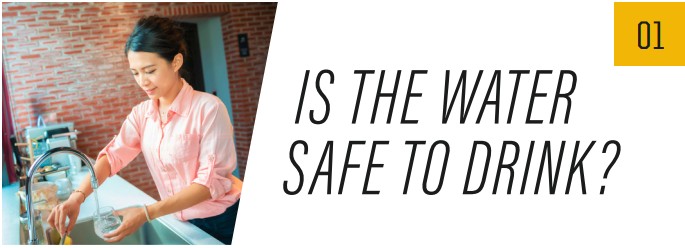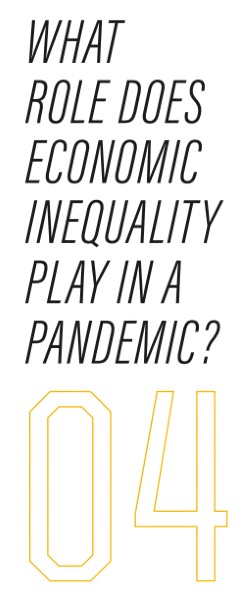Big Questions
Researchers pivot to examine issues related to COVID-19 pandemic

The average person doesn't think twice before drinking from a water fountain. The public assumes the water is safe, that the building manager monitors the water quality. In reality, there are no standardized practices that govern plumbing safety. And water quality is easily compromised when buildings are underutilized and water in pipes remains stagnant for long periods of time. It's a problem exacerbated by the COVID-19 pandemic which led to salons, gyms, offices, municipal buildings, schools and sports venues standing empty for months.
Andrew Whelton, associate professor of civil engineering and environmental and ecological engineering faculty scholar, has researched the preservation and disinfection of water supplies for decades. Now, he and his team have fielded calls from around the world asking for advice on how to test water quality, flush and disinfect systems and ensure that building water is safe for occupants as facilities begin to reopen.
"It's not unusual that building managers don't know how to determine if plumbing is safe," Whelton said. "People have never really thought about it. Public health officials who oversee building occupancy and safety don't have extensive training in plumbing safety. And there are no federal, state, or county regulations to guide them on how to clean that water."
Whelton is developing a course in collaboration with Purdue Online to train public health officials about building water safety. He's also conducting research on buildings that have been sitting idle during the pandemic. This research will contribute significant gains in the area of plumbing safety which currently lacks evidence-based guidance on how to reinstate plumbing systems that sat idle for extended periods of time.
"Many building owners have never thought about plumbing safety because buildings are meant to be used," Whelton said. "When a building is in normal use, there is disinfectant and hot water running through the plumbing systems. When you have water sitting in plumbing for lengthy periods of time, all the chemical disinfectant is gone."
The longer water sits, the more lead and copper leaches into it. Consuming high concentrations of copper can lead to stomach cramps and nausea. Bacteria is also a concern, particularly Legionella pneumophila which causes Legionnaires' disease. The disease is contracted by breathing in droplets of water contaminated by the bacteria. But, Whelton cautions, just because major outbreaks associated with waterborne illness aren't reported, doesn't mean they don't happen.
The Centers for Disease Control issued water safety guidelines for schools as they reopen, encouraging staff and students to bring their own water to minimize use of water fountains. Although the guidelines were specific to schools, the same cautionary principles apply to any facility with significant periods of underuse.
"Circumstances surrounding the pandemic have led to a realization that what people thought they knew about water safety isn't necessarily true," Whelton said. "The assumption that water is safe at every tap is not based on science or evidence. We want to establish protocols for plumbing safety so when a building manager is asked, not only, 'Is the water safe to drink?' but 'What did you test it for? How did you test it?' They will be able to provide evidence-supported results based on established scientific testing procedures."

Stay-home orders issued earlier in the year resulted in many Americans drastically reducing their time away from home. A study led by Jie Shan, professor of civil engineering, analyzed six months' worth of mobility data acquired through the Indiana Department of Transportation (INDOT) to examine traffic patterns and how they were affected by stay-home orders. While INDOT sensors recorded significant drops in vehicular traffic in March, there was almost no change for trucks.
"This tells us two things," Shan said. "First, Indiana citizens largely observed stay-home orders. Second, transportation of consumer goods was relatively unaffected. Supply chains didn't change much, which means the consumer market was still active and people still had access to goods."
Shan's team has been analyzing location-based big data to study mobility patterns to gain a better understanding of people's lifestyle and the urban setting for some time. With the methodology established, they were able to apply the same technology to understand people's mobility related to the pandemic.
But traffic patterns only tell part of the story. Shan's team also analyzed foot traffic data in Chicago, collected via the private sector, to understand how people's mobility changed during and after stay-home orders. By establishing the rate at which people resume trips to the grocery store, restaurants and other businesses, the researchers begin to establish predictive models that can help governmental authorities and policy makers understand what the economic impact has been and what's likely to happen when states reopen. These predictive models have far-reaching potential impact for navigating future outbreaks.
"We're collaborating with domain experts to illustrate how these mobility patterns relate to the number of cases, number of deaths and how that relates to available medical care resources," Shan said. "We want to try to make that link."

At the start of 2020, there were no data to describe how SARSCoV-2, the virus that causes COVID-19, responds to UV radiation. Some preliminary research released in the months since indicates UV is likely to be effective for inactivating the virus. The consumer market has already responded with various devices that claim to eradicate the novel coronavirus from surfaces. The problem is, not only can UV radiation be damaging to human skin and eyes, there's also not enough scientific evidence to support its effectiveness against SARS-CoV-2 yet.
"There's a wide range of people from garage scientists to large corporations that believe UV is likely to be effective, but it hasn't been credibly proven yet," said Ernest "Chip" Blatchley, the Lee A. Rieth Professor in Environmental Engineering. "Should this hypothesis be validated, the possibility for UV technology to dramatically improve our ability to slow the spread of a pandemic or an epidemic has far-reaching implications."
Blatchley has proposed a set of experiments to quantify the effectiveness of UV radiation to inactivate SARS-Cov-2 and related viruses. In order to validate the performance of UV-based systems for control of SARS-CoV-2, it is likely that surrogate, nonpathogenic viruses will need to be released in settings where UV disinfection is planned.
While UV radiation has been used in disinfection practices for more than 100 years, it is dangerous to perform UV disinfection processes when human exposure is possible. But there is emerging research to suggest that far-UVC — a narrow range of wavelengths — may be safe for humans and lethal for viruses; however, the safety of far-UVC has not been conclusively demonstrated. Effective and efficient decontamination of high-use spaces such as classrooms, dining courts and athletic venues would greatly impact a university's ability to more safely operate with students in residence. More broadly, office buildings, public transportation, even aircraft carriers would benefit from such technologies.
"There's an urgent need to get the credible data we need to describe the kinetic behavior of SARS-Cov-2," Blatchley said. "There's an equally urgent need to develop UV applications that can be used for decontamination. We need to better position ourselves to respond to the next epidemic or pandemic."
 Knowing that COVID-19 is spread by coming in contact with others, understanding where people are located and how they are moving about enables researchers to more accurately predict the spread of the disease. Analyzing the real-time location and mobility data of anonymized cell phone users in Japan and the United States, Satish Ukkusuri, professor of civil engineering, discovered trends in the relationship between mobility restrictions and the spread of COVID-19 and how different income groups were affected during the pandemic.
Knowing that COVID-19 is spread by coming in contact with others, understanding where people are located and how they are moving about enables researchers to more accurately predict the spread of the disease. Analyzing the real-time location and mobility data of anonymized cell phone users in Japan and the United States, Satish Ukkusuri, professor of civil engineering, discovered trends in the relationship between mobility restrictions and the spread of COVID-19 and how different income groups were affected during the pandemic.
"Higher income people are able to reduce their social contacts at a much higher rate." Ukkusuri said. "Possibly because of the types of jobs they hold, flexibility of their workplaces and their ability to work from home."
Using the mobility data, Ukkusuri and his team build social contact networks and a social contact index that can be compared over time to determine how those contact networks have evolved. Although the researchers initially focused on Tokyo — the most populous metropolitan area in the world — the predictive models they created based on network science and machine learning can be applied to analyze data from any city to determine how well the population abides by precautions to reduce disease spread.
"One significant factor regarding Tokyo is that because of the cultural norms there, people already use face masks and practice social distancing," Ukkusuri said. "There was not a strict lockdown, but people instinctively restricted their mobility to limit contact with others. Contact with others was reduced by 60 to 70% without any emergency declaration from the city."
The drastic reduction in mobility levels among Tokyo's populace showed a correlation with a decrease of COVID-19 cases. But the data also showed dramatic differences in the ability for people of different income groups and from different locations to restrict mobility thereby reducing contacts. Lower income people may be more likely to hold essential jobs or provide services that cannot be carried out at home, such as retail, restaurant and grocery workers. Similar insights were obtained from the U.S. data.
"We were not expecting significant differences in terms of income inequalities," Ukkusuri said. "We need to understand what inequalities exist during a pandemic and how they relate to disease spread. Establishing those interdependencies and understanding the inequalities and their impact on people is the first step to understanding how to minimize those inequalities during a crisis and enable faster recovery."
